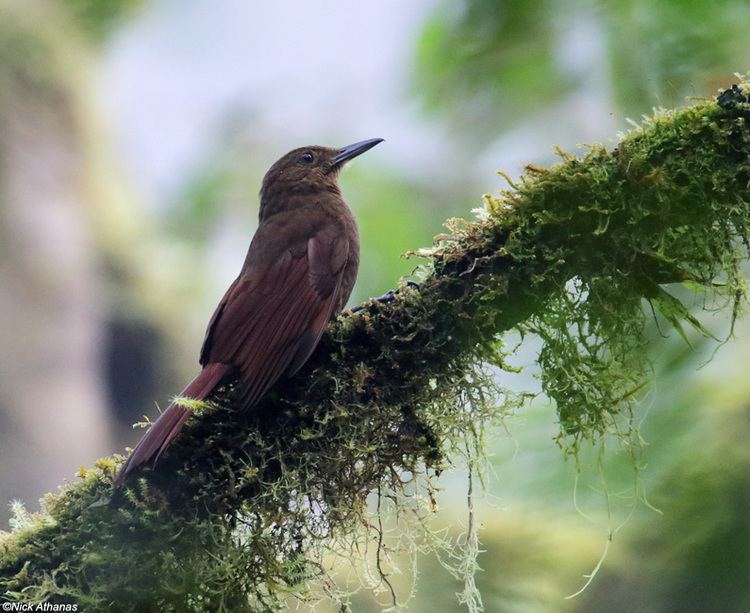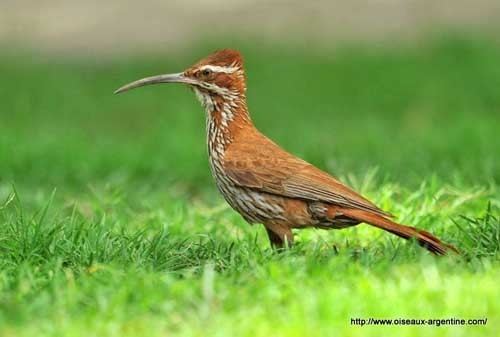Suborder Tyranni Scientific name Dendrocolaptinae Rank Family Family Furnariidae | Class Aves Subfamily Dendrocolaptinae Phylum Chordata Order Passerine | |
 | ||
Similar Ovenbird, Antbird, Xiphorhynchus, Lepidocolaptes, Manakin | ||
Birds of brazil woodpeckers woodcreepers foliage gleaners
The woodcreepers (Dendrocolaptinae) comprise a subfamily of suboscine passerine birds endemic to the Neotropics. They have traditionally been considered a distinct family Dendrocolaptidae, but most authorities now place them as a subfamily of the ovenbirds (Furnariidae). They superficially resemble the Old World treecreepers, but they are unrelated and the similarities are due to convergent evolution. The subfamily contains around 57 species in 15 to 20 genera.
Contents
- Birds of brazil woodpeckers woodcreepers foliage gleaners
- Birds of belize woodpeckers and woodcreepers
- Description
- Habitat and distribution
- Diet and feeding
- Systematics
- References

Woodcreepers range from 14 to 35 cm in length. Generally brownish birds, the true woodcreepers maintain an upright vertical posture, supported by their stiff tail vanes.
They feed mainly on insects taken from tree trunks. However, woodcreepers often form part of the core group at the centre of flocks attending army ant swarms. Woodcreepers are arboreal cavity-nesting birds; two or three white eggs are laid and incubated for about 15 to 21 days.

These birds can be difficult to identify in that they tend to have similar brown upperparts, and the more distinctive underparts are hard to see on a bird pressed against a trunk in deep forest shade. The bill shape, extend/shape of spots/streaks, and call are useful aids to determining species.

Birds of belize woodpeckers and woodcreepers
Description
The woodcreepers are generally fairly uniform in appearance. They range in size from the wedge-billed woodcreeper (13 cm (5.1 in)) to the strong-billed woodcreeper (35 cm (14 in)). Males tend to be slightly larger than females on average, but considerable overlap in size occurs in most species. Pronounced sexual dimorphism in size and plumage is rare. Bill size and shape accounts for much of the variation between the species. Bills can be straight or highly decurved, and can account for as much as a quarter of the length of the bird (as happens in the long-billed woodcreeper). The plumage is usually subdued and often brown, or sometimes rufous or other dark colours. Many species have patterns such as checking, spotting, or barring on their plumage. The feathers of the tail are rigid and are used for supporting the body when climbing tree trunks; the tail can support most of the body weight and birds that lose their tail find climbing difficult. Woodcreepers climb by flexing their legs and hopping up the trunk. The feet of the woodcreepers are also modified for climbing. The front three toes are strongly clawed and the back tow is strong and long. The legs are also strong.
Habitat and distribution
The woodcreepers are generally forest birds of Central and South America. Most species occur in rainforests, with the centre of diversity of the subfamily being the Amazon Basin. As many as 19 species of woodcreeper may co-occur in some areas of the Amazon, although in other rainforests, such as those in Costa Rica, the numbers are much lower. Other habitats used by the woodcreepers include pine-oak woodland, montane cloud forest, and pine forests. A few species inhabit savannah or other partly open environments, but they are absent from the temperate forests of the southern parts of South America.
Diet and feeding
The woodcreepers are insectivores that are mostly arboreal in nature. Insects form the majority of the diet, with some spiders, centipedes, millipedes and even lizards being taken as well. A few specimens collected by scientists had fruit or seeds in their stomachs, but plant material is not thought to be regularly taken by any species. A few species forage on the ground, but most forage on the trunks of trees, on and on the underside of branches. They are generally solitary or occur in pairs, but frequently join mixed-species feeding flocks. The flocks they join are usually the lower level ones rather than canopy flocks, and are usually those insectivorous ones rather than frugivorous ones. Prey is almost always obtained by moving up the trunk or branch, and there are two main foraging techniques, probing and sallying. Probers investigate rough bark, mosses, masses of trapped dead leaves, bromeliads, and other areas where prey may be hiding, whereas those that sally launch into the air briefly to snatch prey that has been flushed by their movement. Several species regularly attend swarms of army ants to catch prey flushed by the ants.
Systematics
The former family has been merged into the ovenbird family, Furnariidae, by most authorities. Analyses of mt and nDNA sequence data showed Sclerurus leaftossers and Geositta miners to be basal to the Furnariidae and the woodcreepers. Maintaining Dendrocolaptidae as a separate family between them and the other furnariids created a paraphyletic Furnariidae, hence the merger. An alternative option was recommended by Moyle et al. (2009), in which the woodcreepers maintain their status as a family, while the ovenbirds (as traditionally defined) are split into two families: Scleruridae and Furnariidae.
The xenops, which have usually been considered ovenbirds with a somewhat woodcreeper-like plumage, are problematic. They have recently been considered related to the woodcreepers, while others have found them to be closer to the "traditional" ovenbirds. If considered closer to the woodcreepers, they form a separate tribe and may give a good impression of how the ancestors of the woodcreepers must have looked like. The true woodcreepers are characterized by a belly feather growth pattern not found in any other birds. A 2013 study of the suboscines found that the genus was not close to either subfamily and should instead be elevated to family rank.
The systematics of the Dendrocolaptinae were reviewed by Raikow (1994, based on morphology) and Irestedt et al. (2004, based on analysis of nuclear and mitochondrial DNA sequences). As the latter paper revealed, the commonplace convergent evolution of bill morphology hampered Raikow's analysis. Colour patterns, on the other hand, were more in agreement with the molecular data, but the generally drab colouration of the woodcreepers renders this character less informative than desirable. The work of Irested et al., on the other hand, was severely limited by unavailability of samples of many phylogenetically interesting taxa.
For example, the Deconychura species apparently belong into separate genera, but only D. longicauda was available for molecular analysis. Moving Lepidocolaptes fuscus to Xiphorhynchus restores monophyly of Lepidocolaptes, and Xiphorhynchus was very much under-split. Hylexetastes may contain anything from one to four species.
It remains unresolved whether the scimitar-billed and long-billed woodcreepers' distinctiveness is due to strong selective pressure (and therefore rapid morphological evolution) of forms related to Lepidocolaptes and Dendrexetastes, respectively, or to long-time evolution of distinct lineages which separated early in the evolution of the group, with genetic similarity due to long branch attraction. The data gained from the myoglobin intron II DNA sequence disagrees strongly with mtDNA cytochrome b sequence data regarding the validity of Lepidocolaptes in general Irestedt et al. (2004); as the latter agrees much better with morphological and biogeographical data it therefore is used here.
More detailed studies are needed to resolve these questions, namely re-evaluation of morphological data in the light of the molecular findings, and new molecular studies which thoroughly sample the questionable genera.
Additionally, the species-level taxonomy of several groups requires further study. Examples of "species" where vocal and morphological variations suggests that more than one species-level taxon could be involved are the curve-billed scythebill and the white-chinned, olivaceous, strong-billed and straight-billed woodcreepers.
FAMILY FURNARIIDAE
Subfamily Dendrocolaptinae – woodcreepers
Tribe Xenopini – xenops
Tribe Dendrocolaptini – true woodcreepers
